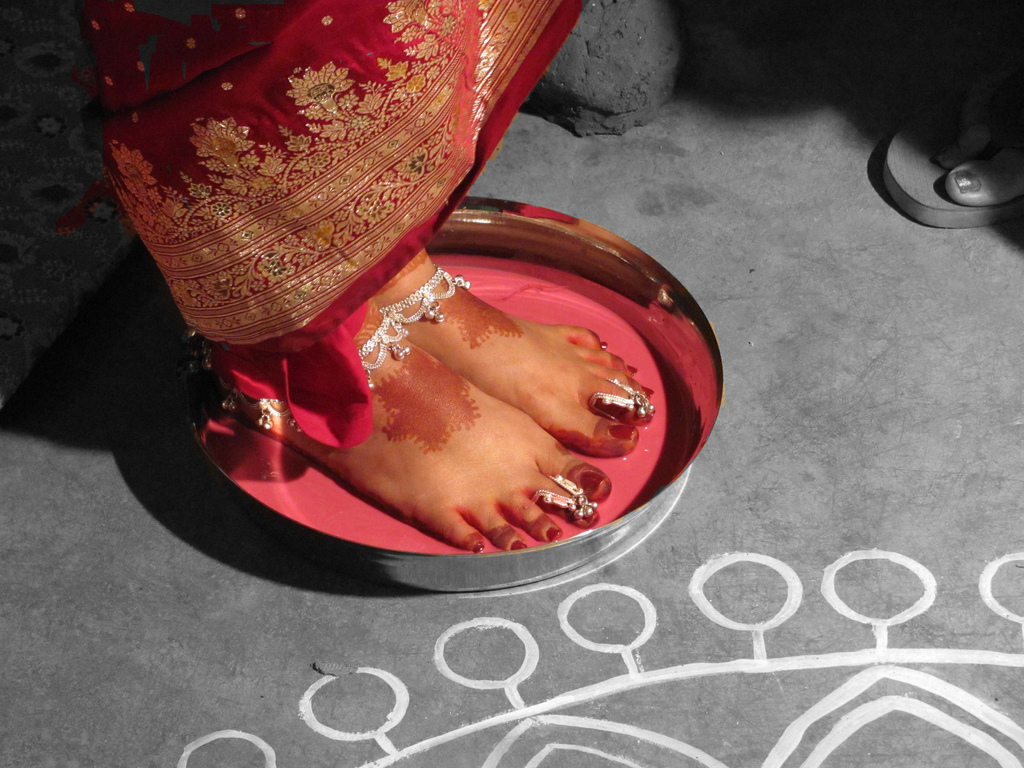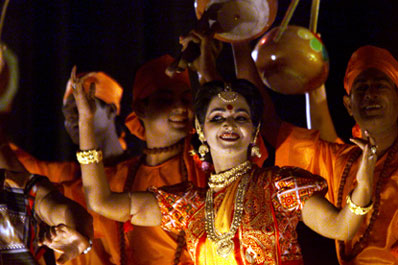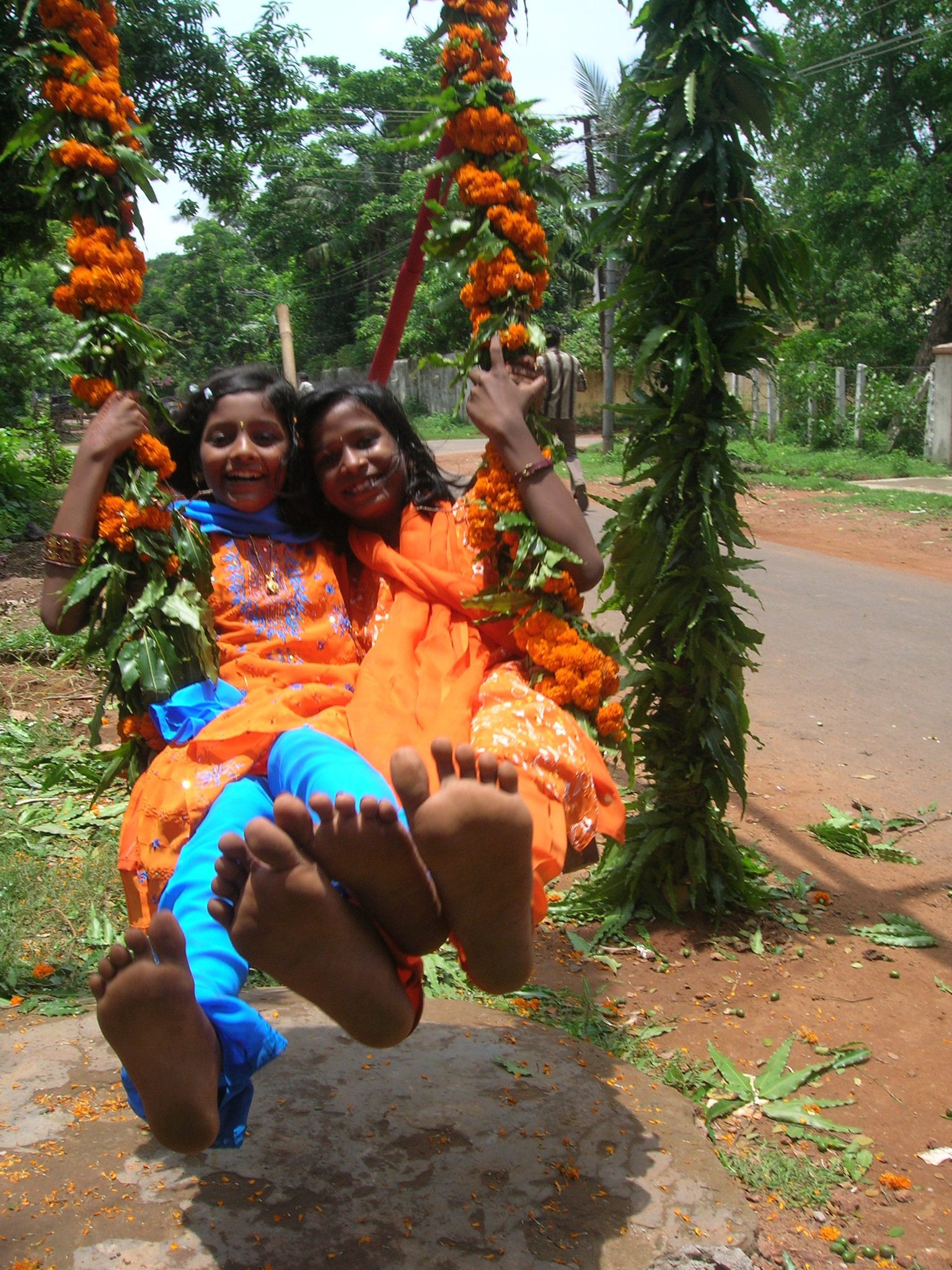|
Alta (dye)
Alta ( bn, আলতা ) ( od, ଅଳତା ), alah or mahavar is a red dye that is applied to the hands and feet of women, mainly in the Indian subcontinent. It is applied with a cotton swab or brush to the hands and feet during marriage ceremonies and festivals. Alta is originally produced from lac, although today it is mainly replaced with synthetic dyes. Cultural significance Bengali culture Alta has great cultural significance in Bengali Culture. Regardless of religious beliefs, Bengali women in Bangladesh and Indian States of West Bengal as well as Tripura, Assam traditionally adorn their hands and feet with alta for marriage and cultural festivals like Pahela Baishakh, Pahela Falgun and others. Wearing Alta on Durga Pooja is a common ritual for Odia & Bengali womenfolk. Odia culture Alta is also significant in Odisha. It can be commonly seen worn by Odissi classical dancers on hands and feet while performing. It is especially prevalent during Raja or Mithun Sana ... [...More Info...] [...Related Items...] OR: [Wikipedia] [Google] [Baidu] |
Odissi
Odissi (), also referred to as Orissi in old literature, is a major ancient Indian classical dance that originated in the Hindu temple, temples of Odisha – an eastern coastal state of India.Odissi ''Encyclopædia Britannica'' (2013) Odissi, in its history, was performed predominantly by women, and expressed religious stories and spirital ideas, particularly of Vaishnavism through songs written and composed according to the ''ragas'' & ''talas'' of Odissi music by ancient poets of the state. Odissi performances have also expressed ideas of other traditions such as those related to Hindu Gods Shiva and Surya, as well as Hindu Goddesses (Shaktism)., Quote: "There are other temples too in Odisha where the ''maharis'' used to dance. Besides the temple of ... [...More Info...] [...Related Items...] OR: [Wikipedia] [Google] [Baidu] |
Festivals Of Bangladeshi Culture
A festival is an event ordinarily celebrated by a community and centering on some characteristic aspect or aspects of that community and its religion or cultures. It is often marked as a local or national holiday, mela, or eid. A festival constitutes typical cases of glocalization, as well as the high culture-low culture interrelationship. Next to religion and folklore, a significant origin is agricultural. Food is such a vital resource that many festivals are associated with harvest time. Religious commemoration and thanksgiving for good harvests are blended in events that take place in autumn, such as Halloween in the northern hemisphere and Easter in the southern. Festivals often serve to fulfill specific communal purposes, especially in regard to commemoration or thanking to the gods, goddesses or saints: they are called patronal festivals. They may also provide entertainment, which was particularly important to local communities before the advent of mass-produced entert ... [...More Info...] [...Related Items...] OR: [Wikipedia] [Google] [Baidu] |
Bangladeshi Wedding Traditions
Bangladeshis ( bn, বাংলাদেশী ) are the citizens of Bangladesh, a South Asian country centered on the transnational historical region of Bengal along the eponymous bay. Bangladeshi citizenship was formed in 1971, when the permanent residents of the former East Pakistan were transformed into citizens of a new republic. Bangladesh is the world's eighth most populous nation. The vast majority of Bangladeshis are ethnolingustically Bengalis, an Indo-Aryan people. The population of Bangladesh is concentrated in the fertile Bengal delta, which has been the center of urban and agrarian civilizations for millennia. The country's highlands, including the Chittagong Hill Tracts and parts of the Sylhet Division, are home to various tribal minorities. Bengali Muslims are the predominant ethnoreligious group of Bangladesh with a population of 150.36 million, which makes up 91.04% of the country's population as of 2022. The minority Bengali Hindu population made up appr ... [...More Info...] [...Related Items...] OR: [Wikipedia] [Google] [Baidu] |
Bangladeshi Culture
The culture of Bangladesh is intertwined with the culture of the ''Bengal region'' of the Indian subcontinent. It has evolved over the centuries and encompasses the cultural diversity of several social groups of Bangladesh. The Bengal Renaissance of the 18th early 19th centuries, noted Bengali writers, saints, authors, scientists, researchers, thinkers, music composers, painters, film-makers have played a significant role in the development of Bengali culture. The Bengal Renaissance contained the seeds of a nascent political Indian nationalism which was the precursor in many ways to modern Indian artistic cultural expression. According to M. Nazrul Islam Tamij, a human rights activist and chairman of the National Human Rights Society (NHRS), human rights are the most important part of Bengali culture, and it plays an important role in the development of Bengali culture. The cultures of Bangladesh composite over the centuries have assimilated influences of Islam, Hinduism, ... [...More Info...] [...Related Items...] OR: [Wikipedia] [Google] [Baidu] |
Indian Wedding Traditions
Indian or Indians may refer to: Peoples South Asia * Indian people, people of Indian nationality, or people who have an Indian ancestor ** Non-resident Indian, a citizen of India who has temporarily emigrated to another country * South Asian ethnic groups, referring to people of the Indian subcontinent, as well as the greater South Asia region prior to the 1947 partition of India * Anglo-Indians, people with mixed Indian and British ancestry, or people of British descent born or living in the Indian subcontinent * East Indians, a Christian community in India Europe * British Indians, British people of Indian origin The Americas * Indo-Canadians, Canadian people of Indian origin * Indian Americans, American people of Indian origin * Indigenous peoples of the Americas, the pre-Columbian inhabitants of the Americas and their descendants ** Plains Indians, the common name for the Native Americans who lived on the Great Plains of North America ** Native Americans in the Uni ... [...More Info...] [...Related Items...] OR: [Wikipedia] [Google] [Baidu] |
Indian Culture
Indian culture is the heritage of social norms, ethical values, traditional customs, belief systems, political systems, artifacts and technologies that originated in or are associated with the ethno-linguistically diverse India. The term also applies beyond India to countries and cultures whose histories are strongly connected to India by immigration, colonisation, or influence, particularly in South Asia and Southeast Asia. India's languages, religions, dance, music, architecture, food and customs differ from place to place within the country. Indian culture, often labelled as a combination of several cultures, has been influenced by a history that is several millennia old, beginning with the Indus Valley civilization and other early cultural areas.John Keay (2012), ''India: A History'', 2nd Ed – Revised and Updated, Grove Press / Harper Collins, , see Introduction and Chapters 3 through 11Mohammada, Malika (2007), ''The foundations of the composite culture in India' ... [...More Info...] [...Related Items...] OR: [Wikipedia] [Google] [Baidu] |
Sindoor
Sindooram is a traditional vermilion red or orange-red coloured cosmetic powder from the Indian subcontinent, usually worn by married women along the part of their hairline. In Hindu communities the sindoor is a visual marker of marital status of a woman and ceasing to wear it usually implies widowhood. The main component of traditional sindooram is usually cinnabar (cinnabar is mercury sulfide, a toxic mineral), turmeric and lime. Some commercial sindoor products contain synthetic ingredients, some of which are not manufactured to proper standards and may contain lead. Application of sindoor Sindoor is traditionally applied at the beginning or completely along the parting-line of a woman’s hair (also called ''mang'' in Hindi or ''simandarekha'' in Sanskrit) or as a dot on the forehead. Sindoor is the mark of a married woman in Hinduism. Single women wear the bindi in different colours for special occasions but don't apply sindoor in their parting of the hairline. Widow ... [...More Info...] [...Related Items...] OR: [Wikipedia] [Google] [Baidu] |
Kumkum
Kumkuma is a powder used for social and religious markings in India. It is made from turmeric or any other local materials. The turmeric is dried and powdered with a bit of slaked lime, which turns the rich yellow powder into a red color. In India, it is known by many names including ''kuṅkumam'' (Sanskrit कुङ्कुमम्, Tamil குங்குமம், and Malayalam കുങ്കുമം), ''kumkuma'' (Telugu కుంకుమ), ''kukum'' ( Konkani कुकूम्), ''kunku'' (Marathi कुंकू and Gujarati કંકુ), ''kumkum'' (Bengali কুমকুম and Hindi कुमकुम), and ''kunkuma'' (Kannada ಕುಂಕುಮ). Application Kumkuma is most often applied by Indians to the forehead. The reason involves the ancient Indian belief that "the human body is divided into seven vortices of energy, called chakras, beginning at the base of the spine and ending at the top of the head. The sixth chakra, also known as the third eye, is ... [...More Info...] [...Related Items...] OR: [Wikipedia] [Google] [Baidu] |
Henna
Henna is a dye prepared from the plant ''Lawsonia inermis'', also known as the henna tree, the mignonette tree, and the Egyptian privet, the sole species of the genus ''Lawsonia''. ''Henna'' can also refer to the temporary body art resulting from the staining of the skin from the dyes. After henna stains reach their peak color, they hold for a few days, then gradually wear off by way of exfoliation, typically within one to three weeks. Henna has been used since antiquity in ancient Egypt and Indian subcontinent to dye skin, hair and fingernails, as well as fabrics including silk, wool, and leather. Historically, henna was used in West Asia including the Arabian Peninsula and in Carthage, other parts of North Africa, West Africa, Central Africa, the Horn of Africa and the Indian subcontinent. The name "henna" is used in other skin and hair dyes, such as ''black henna'' and ''neutral henna'', neither of which is derived from the henna plant. Etymology The English name "henna ... [...More Info...] [...Related Items...] OR: [Wikipedia] [Google] [Baidu] |
Odia People
The Odia (), formerly spelled Oriya, is an Indo-Aryan ethnic group native to the Indian state of Odisha who speak Odia language. They constitute a majority in the eastern coastal state, with significant minority populations in neighboring Andhra Pradesh, Chhattisgarh, Jharkhand and West Bengal. Etymology The earliest Odias were called Odra or Kalinga, which later on became Utkal. The word Odia has mentions in epics like the ''Mahabharata''. The Odras are mentioned as one of the peoples that fought in the ''Mahabharata''. Pali literature calls them Oddakas. Ptolemy and Pliny the Elder also refer to the Oretas who inhabit India's eastern coast. The modern term Odia dates from the 15th century when it was used by the medieval Muslim chroniclers and adopted by the Gajapati kings of Odisha. History Ancient period The Odias are distinguished by their ethnocultural customs as well as the use of the Odia language. Odisha's relative isolation and the lack of any discernible o ... [...More Info...] [...Related Items...] OR: [Wikipedia] [Google] [Baidu] |
Raja (festival)
Raja Parba (, ), also known as ''Mithuna Sankranti'', is a three-day-long festival of womanhood celebrated in Odisha, India. The second day of the festival signifies beginning of the solar month of Mithuna from, which the season of rains starts. Mythology It is believed that the mother Goddess Earth or the divine wife of Lord Vishnu undergoes menstruation during the first three days. The fourth day is called ''Vasumati Snana'', or ceremonial bath of Bhudevi. The term Raja came from the Sanskrit word '''Rajas''' which means menstruation and when a woman menstruates, she is called Rajaswala''' or a menstruating woman, and in medieval times the festival became more popular as an agricultural holiday marking the worship of Bhudevi, who is the wife of lord Jagannath. A silver idol of Bhudevi is still to be found in the Puri Temple beside Lord Jagannath . Rajaparba It falls in mid June, the first day is called Pahili Raja, second day is Mithuna Sankranti, third day is Bhudaaha or Bas ... [...More Info...] [...Related Items...] OR: [Wikipedia] [Google] [Baidu] |






a.jpg)

